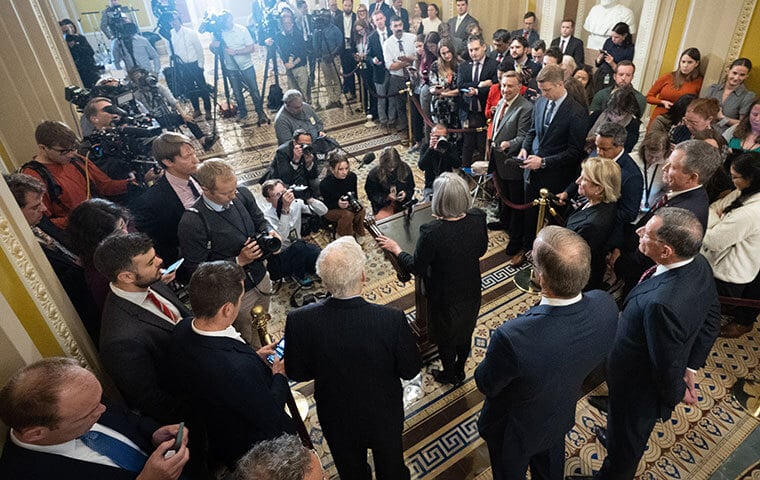 Sen. Joni Ernst, R-Iowa, seen at her weekly briefing outside the Senate Chamber, released a report stressing commonly voiced criticisms of telework rates, with figures differing greatly than those put out by OMB. Image: Douglas Christian/ZUMA Press Wire/Shutterstock
By: FEDweek Staff
Sen. Joni Ernst, R-Iowa, seen at her weekly briefing outside the Senate Chamber, released a report stressing commonly voiced criticisms of telework rates, with figures differing greatly than those put out by OMB. Image: Douglas Christian/ZUMA Press Wire/Shutterstock
By: FEDweek StaffTelework by federal employees and the intertwined issue of the role of federal unions in workplace policies are shaping up as early battlegrounds for the incoming Trump administration and a Congress that will be fully under Republican control starting in January.
Those have been two of the main areas of emphasis as Capitol Hill Republicans have been meeting with leaders of the upcoming “department of government efficiency”—not a federal agency with direct powers but only an advisory commission—and planning to coordinate policy ideas into actions. Informal “DOGE” caucuses have arisen in both the House and Senate, while the House Oversight and Accountability Committee will stand up a subcommittee specifically focused on that commission’s work in the new Congress.
One of the leaders on the Senate side, Sen. Joni Ernst, R-Iowa, raised further attention to the telework issue by releasing a report stressing commonly voiced criticisms of telework rates that remain high by historic standards. Those include assertions that telework has degraded service to the public, that many employees are incorrectly receiving higher rates of locality pay based on their office’s location although they work full-time or nearly so in a lower-cost area, and that many federal buildings are substantially under-used.
However, that report—which she and other Republicans have been using in public comments to build a case for returning offsite work to pre-pandemic levels—contains inaccuracies, including that “Today, six percent of workers report in-person on a full-time basis, while nearly one-third are entirely remote.”
A recent report from OMB stated that 54 percent of federal employees do not telework at all because of the nature of their work, that those who do telework on average are in the office three days a week—although rates vary by agency—and that about 10 percent are “remote” workers who are not expected to regularly report to an agency site.
Office vacancy rates have been an ongoing issue especially since a 2023 GAO report, and several inspector general reports have raised the issue of employees receiving incorrect locality pay, although the practice has not been found to be widespread. But neither the OMB report nor a separate recent GAO report were able to draw specific conclusions about the impact on productivity, with GAO citing the difficulty of isolating its impact among other factors such as workload changes and adequacy of staffing levels.
Meanwhile, the SSA and the AFGE union have mutually agreed to extend until at least 2029 the telework provisions in their main contract, which among other things allow for two days of offsite work per week for field office workers.
In response, Rep. James Comer, R-Ky., who will continue to lead the House oversight committee in the new Congress, has written to two dozen agencies asking for a list of all ongoing negotiations, whether they are expected to be completed before the end of the current administration, and any contracts extensions that have been agreed to or are pending.
“Requiring an incoming President to bargain with federal employee unions for the right to implement his policies is a ceding of executive power—not to Congress or the Judiciary—but to select federal employees and the unions that represent them,” he wrote.
In a request that is not likely to be granted, he urged the agencies to “cease negotiating or extending collective bargaining agreements with respect to a workforce it will have no responsibility to manage going forward.”
The Trump administration is widely expected to reinstate several executive orders, which the Biden administration revoked, to speed up bargaining, limit its scope and set standards for agencies on negotiable matters such as allowable “official time.” However, due to their binding nature, contracts with unions cannot be as easily disavowed, a point the unions have stressed even during the pro-union Biden administration to push back against agency moves to require more onsite work.
Senate Eyes Vote to Pay Federal Employees Working Unpaid
Series of Bills Offered to Address Shutdown’s Impact on Employees
Public Starting to Feel Impact of Shutdown, Survey Shows
OPM Details Coverage Changes, Plan Dropouts for FEHB/PSHB in 2026
Does My FEHB/PSHB Plan Stack Up? Here’s How to Tell
2025 TSP Rollercoaster and the G Fund Merry-go-Round
See also,
TSP Takes Step toward Upcoming In-Plan Roth Conversions
5 Steps to Protect Your Federal Job During the Shutdown
Over 30K TSP Accounts Have Crossed the Million Mark in 2025

